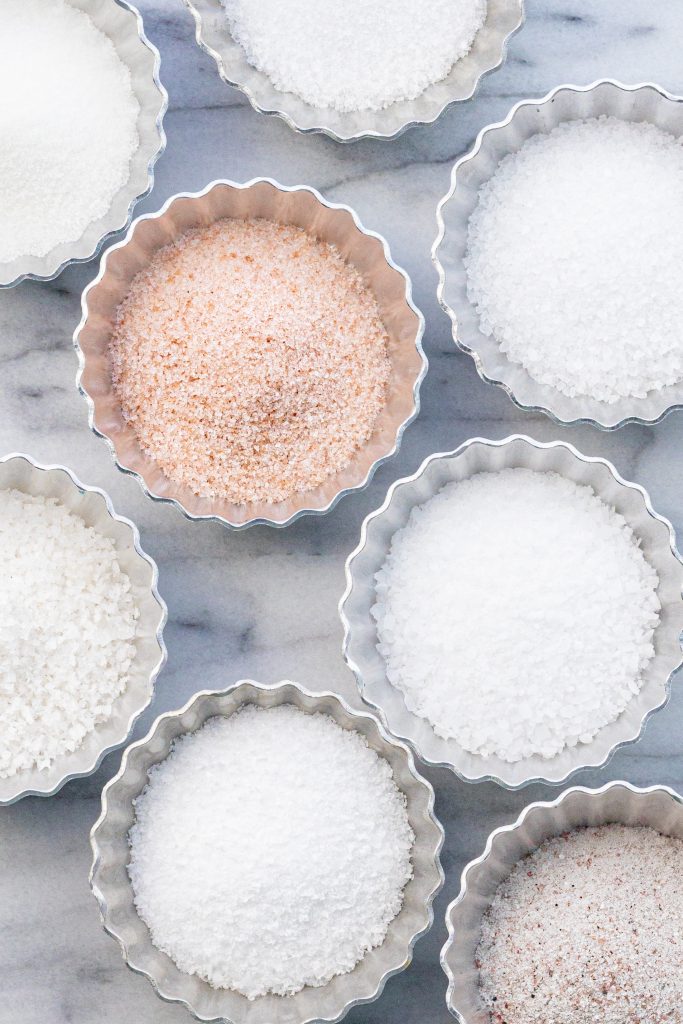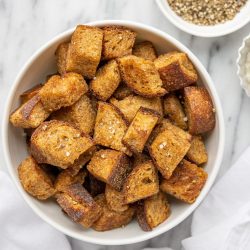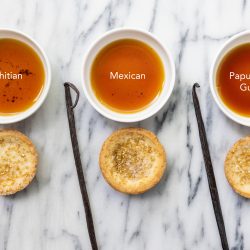We use salt in almost every single recipe at BAKE!, whether it’s for baking or cooking. Salt plays multiple roles in our recipes: It brings out the flavors of other ingredients, aids with browning, helps control the growth of yeast in yeasted doughs, and strengthens the gluten and gliadin proteins found in wheat flour to give our doughs strength and structure.

I’ve been thinking a lot about salt since we started our virtual classes at BAKE!. Since students are baking at home, in their own kitchens, we all have different types of salt in our cabinets, which makes sense, when we are presented with dozens of different types of salt in the grocery store. Some salts are pink, some are red, some are iodized, and some are kosher. The variety is staggering; salt can come from the mountains in the Himalayas and the ocean shores of Hawaii. I once bought salt up the side of the muddy rainforest-y mountain range in Peru, where farmers each had their own plot of salt to rake and dry. But not all salt is hand-harvested, it can be commercially produced and processed, too—by solar evaporation (sunlight), underground mining (heavy machinery), or by vacuum evaporation (complex and please don’t ask).
Clearly, not all salts are created equal. There is variability in the amount of ‘saltiness’ (somewhat subjective), how ‘clean’ salt tastes (ditto), and their different applications. Salts have different granule sizes and moisture contents (the rice you will sometimes find in salt shakers is used to absorb that moisture and keep the salt from clumping).
Take it with a grain of salt
My thoughts always go back to a recipe I was making for fried chicken that specifically called for 2 teaspoons of Diamond Crystal salt. I thought, “Coarse salt is coarse salt, what’s the difference?,” and proceeded to use two teaspoons of Morton Kosher salt. This was a big, fat mistake. The differing granule sizes between the two meant that 1 teaspoon of Diamond Crystal (fattier, fluffier crystals) was not the same as 1 teaspoon of Morton Kosher salt (denser, more circular crystals). The end result of my fried chicken was practically inedible; way too salty!
At Zingerman’s, we use fine-grain sea salt. We like the flavor and the finer granule as the smaller size better distributes itself in our baked goods. But, given that we might have a variety of salts on hand in our own home kitchens, I wanted to do a test to measure the weights of different types of salt, see their variability in volume, and offer some suggestions for how to manage their differences for kitchen success.
A salty experiment
I went to By the Pound in Ann Arbor, a bulk foods store where you can buy everything from flours to noodles and snacks to spices, you guessed it… by the pound. I bought a variety of salts, then went home and got out my microgram scale, which measures to one-hundredth of a gram, and a teaspoon measuring spoon. For each of the salts, I measured 1 teaspoon, 10 times. I took an average of all ten measurements. Here are my results:
 Himalayan Pink Salt: 6.14 grams
Himalayan Pink Salt: 6.14 grams
Morton Kosher Salt: 5.98 grams
Fleur de Sel: 4.29 grams
Fine Sea Salt: 5.98 grams
Coarse Sea Salt: 6.3 grams
Iodized Salt: 6.41 grams
Diamond Crystal: 2.8 grams
Black Hawaiian Salt: 6.03 grams
Coarse Sea Salt: 5.65 grams
Zingerman’s Sea Salt: 5.86 grams
Whoa!
Things worth noting:
- Across my 10 measurements for each type of salt, in only one instance with one salt were my measurements the same, despite my best intentions to be as deliberate as possible. The variability among salts was +/-.10 grams.
- 5-6 grams was the standard average measurement for most of the salts.
- Diamond Crystal was the lightest salt, by almost half.
- Iodized salt was the heaviest.
Does this mean I need to buy a microgram scale?
No, you do not need to buy a microgram scale; most recipes out there acknowledge that a teaspoon of a fine salt will be around 5-6 grams and I have never seen a recipe that called for 5.5 grams of salt. For the home baker and a recipe that calls for 2 teaspoons of salt, that potential 2-gram difference either way will not make or break a recipe. However, if I was making multiple loaves of bread and needed multiple teaspoons of salt, those small differences would add up.
So what does it all mean? Why should I care?
Biggest Takeaway: 5 grams of salt is 5 grams of salt. So, if you are using a scale that registers in single grams, then whether you use Diamond Crystal or iodized salt, won’t matter.
The difference is in a teaspoon of salt by volume. This is why my overly salty fried chicken happened. By weight, I had used almost twice as much salt as the recipe called for.
If you are using a salt with a larger granule size, consider dissolving the salt first in a little bit of the liquid and then adding it into the recipe. This will help prevent large chunks of salt from not getting incorporated into your recipe. We always suggest that students buy scales that go up in single gram increments.
And, as always, FOLLOW THE RECIPE!
BAKE! Principal and Instructor
At the age of 4, Sara climbed on the kitchen counter to 'taste' vanilla extract. Disappointed by the taste (how could something that smelled so good taste so bad?), she was caught by her mother and had to sheepishly explain what she was up to. Fast forward ten years and Sara was selling homemade sandwiches and cookies to her friends at lunch and still running lemonade stands with her best friend. This love of all things food, and especially baking, led Sara to the Culinary Institute of America where she got her degree in baking and pastry arts. She baked and cooked her way across the country, working everywhere from NYC to San Francisco, Atlanta, Alaska, North Dakota, and even Cambridge, England.
Sara received her master's degree in hospitality management from Cornell University, where she helped teach and develop curriculum for an undergraduate restaurant course. After years of wondering how Zingerman's made their deliciously perfect Cosmic Cakes, she is thrilled to be a part of the team and learn the secrets to pass on to BAKE! students.



